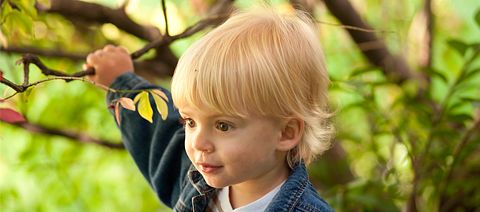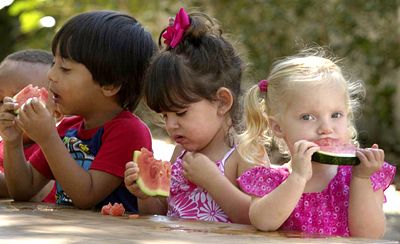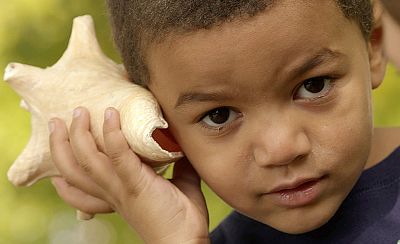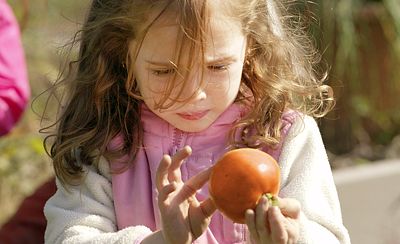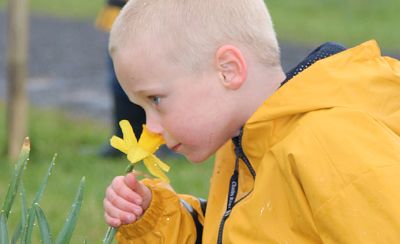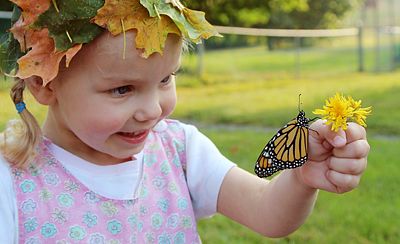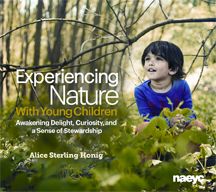Awakening the Senses
Connecting Children to the Wonder of Nature
|
May 2015
Give a baby a chunk of ripe banana. She licks and bites off some to chew with her few little teeth experiencing the taste and texture with her mouth. She squashes that banana chunk slowly through her fingers, feeling the texture with her fingers.
A preschooler finds a slimy earthworm while digging outside in the yard and holds up this wiggly creature with amazement and excitement. Children do not share the aversion that some grown-ups have acquired about squirmy or slithery creatures!
The world is a place of wonders! Children enjoy sensory experiences with a delight seldom matched by adults. Early childhood educators emphasize that “young children learn with their whole body” but do children have enough opportunities to use all their senses actively? Teachers need to plan opportunities for sensory exploration intentionally, both indoors and out Think of each of the senses and then plan experiences for each season of the year which will awaken sensory joy for each child as well as provide interesting learning experiences.
Taste
The sense of taste is one of the first ways in which infants explore the world. Young toddlers will instinctively put an object in their mouth to investigate its properties. An extensive kaleidoscope of taste and texture is offered daily at eating times. Food textures, tastes, and colors vary widely. Watermelon feels light and drippy. Peanut butter feels sticky in the mouth and on the fingers. Bananas are soft and mushy. Take advantage of these experiences to arouse the children’s curiosity and appreciation of the wide variety of tastes and textures present in food. Giving vocabulary to describe these different sensory experiences embellishes tasting times.
Hearing
The world is full of sounds. Children respond from a very early age to frequently heard noises. When only a few weeks old, a baby will turn at the sound of a familiar voice. Hearing a guitar strummed, a baby will search until his eyes light on the fingers plucking the guitar strings.
The great outdoors offers a wide spectrum of sounds. Often children need help to tune into particular noises. Before taking a walk outdoors, talk with the children about different sounds they might hear. Ask children to listen for leaves crunching underfoot, the wind whooshing through branches on a windy day, a frog calling from a nearby pond, or a rustling in the underbrush. If children live in cities, they will hear horns honking, buses roaring, police car sirens wailing, or trolleys clanging.
Listening for, and identifying, bird calls is a wonderful way to enhance sensory acuity. Some birds, like crows, have raucous cries. Others birds chirp cheerily. Some birds sing sweet melodious notes over and over. Mourning doves coo in low, easy-to-identify tones. If a cricket manages to find the way into your classroom, children will listen with special attention. Like good detectives, they will track down the location of those chirps, until they find the little creature and then bring it safely outdoors. All of these experiences offer valuable opportunities for conversation and a honing of observation skills.
Touch
The sense of touch is very important for young children. Research shows that infants who are stroked, massaged, caressed, and cuddled have better brain growth. For some young children, stroking a soft blanket, twisting their hair, or sucking their thumb seems necessary for comfort and security. Teachers can cultivate this sensitivity to textures into powerful learning opportunities that can enrich language and observation skills.
Provide a variety of textures of cloth such as velour, terry cloth, or puckered fabrics for the children to play with and explore the different cloth textures. Indoors, sensory tables can be filled with sand or rice. Water table play provides hours of delight and discovery as the children experiment with funnels and sieves, enjoying all the ways in which water drips, dribbles, sprays, and splashes. Outdoors, go on a tree-hugging walk where children feel the bark of different trees. They may get all excited explaining to you how smooth the bark feels on a beech tree and how rough on a maple tree. Look at the leaves—can the children describe the differences in texture as well as the different sizes and shapes of some leaves?
Vegetables and fruits can also be used to teach textures. The bumpy skin of a cucumber feels different from the skin of an apple or green pea, a banana peel, the rough skin of a raw beet, the slippery skin of a grape, or the fuzzy feel of a kiwi fruit. Put a variety of such raw edibles in a bowl. With eyes closed, a child reaches in and touches a vegetable or fruit and calls out the name just by feeling the skin. Increase the challenge by adding different kinds of nuts to the bowl. Matching a name to each tactile experience is a game that sharpens sensory touch awareness and also sharpens cognitive categorization skills.
Smell
Children are adept at recognizing smells. They love to sniff scent jars containing vanilla, cinnamon, or citrus smells. Many children can recognize the familiar smell of different fruits with their eyes closed. Children wrinkle up their noses to smell fragrant flowers. If your neighborhood has a community garden with flowering plants, especially rose bushes, be sure to take the children there in June at peak blooming time for roses. Ask them to sniff each different rose and discuss which ones have almost no smell and which ones indeed smell “just like a rose”!
What other kinds of smells can the children tell you about? Most youngsters can tell you excitedly that a skunk must have been in their neighborhood the evening before because of the pungent odor still lingering the next morning. They may remember the acrid smell of smoke from a camp fire if their family has taken them on a camping trip. The sense of smell, easy to awaken through the events of daily life, can help expand children’s knowledge of their environment.
Sight
As a part of your morning greeting ritual, ask children to share what they noticed on the way to your program. Children are exceptionally observant but often need help to find the language to describe what they have seen. Going outdoors with your class provides a variety of sights, colors, and visual experiences for children. Teachers are children’s personal guides to awaken a sense of awe and rejoicing in the variety and richness of nature.
Identifying birds or flowers will help sharpen children’s visual processing skills. Even if you don’t live in an area teeming with nature, there are sure to be weeds growing abundantly. Or go on a bug hunt! Sometimes that will involve tramping through grass or looking under rocks. Sometimes children just want to lie still on their tummies and watch little ants going about daily chores or watch a grasshopper jump. Walking through a garden, children can spy bees collecting pollen from different plants or observe butterflies delicately sipping nectar from a flower.
Conclusion
As children look for leaves and bugs, sniff flowers and fruits, and listen for birds or the patter of rain, they are enriching their sensory awareness and attunement to nature and the environment. The teacher acts as a guide to expand a child’s sense of delight and provides vocabulary to describe what the children are experiencing. As a child’s awareness of the world grows, his love of nature increases.
This article is adapted from Chapter 1 of Experiencing Nature with Young Children. Awakening Delight, Curiosity, and a Sense of Stewardship. published by the National Association for the Education of Young Children. (You can order by calling 1-800-424-2460).

